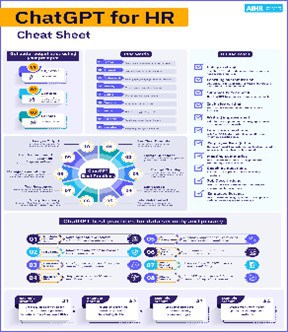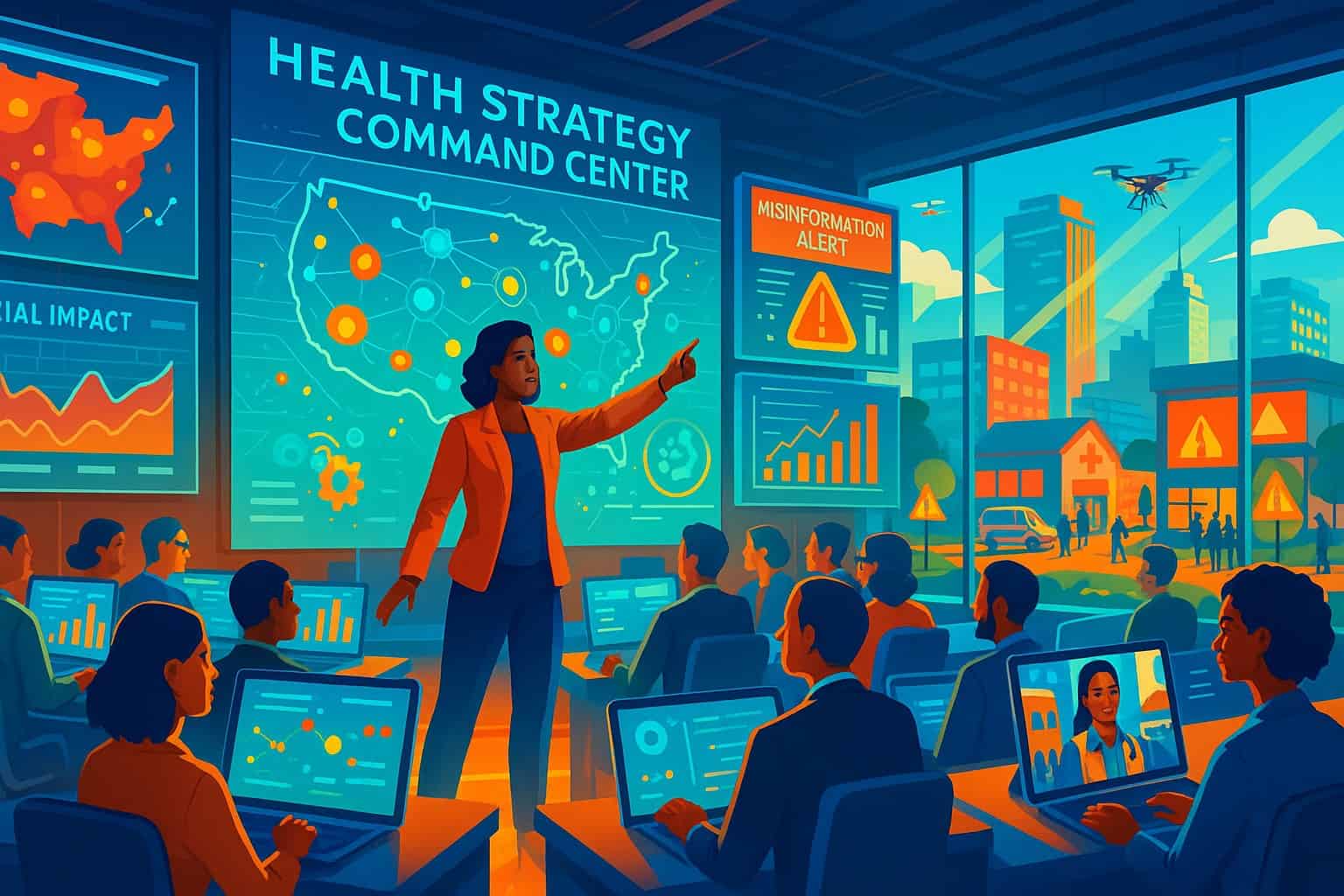Will AI help close labor gaps in behavioral health?
Table of Contents
AI: Your Partner in Health System Innovation
Generative AI offers exciting potential to overcome health system fragmentation. This series provides practical insights for leaders using AI tools to develop integrated, accountable systems focused on SDOH. Generative AI produces new content based on learned data patterns. ChatGPT, a language model powered by this technology, offers health professionals an efficient assistant to generate ideas, draft plans, and enhance decision-making, helping to drive leadership development and systemic improvements.
Use the questions to guide team learning, explore hyperlinked resources, and provide feedback to enhance the effectiveness of these strategies.
Your Blip-Zip Challenge on Embracing AI and ChatGPT
Your Task is to forecast health workforce needs for a growing population. How could ChatGPT prompt aggregate labor market trends to generate insights? What Role could AI play in building adaptive workforce development plans? How do you manage uncertainties and ethical risks associated with AI-based forecasting? Provide examples of personal experiences, case studies, guides, links, and references as part of your response.
Just In Time! ChatGPT Prompt Development Tips and Tricks
To help you answer these questions, here is an overview and application of the visual ChatGPT for HR Cheat Sheet by Neelie Verlinden. The cheat sheet is designed to provide tips and tricks for using ChatGPT in human resources (HR) functions. If the visual is blurry, Google the Title. It covers various topics such as recruitment, onboarding, employee engagement, and performance management.

Effective prompts can significantly enhance the productivity of HR professionals. According to a recent MIT study, using well-crafted ChatGPT prompts can speed up HR tasks by up to 37% and improve work quality by 20%. This guide focuses on prompt engineering and provides 23 practical ChatGPT prompts tailored for HR tasks.
It’s essential to understand the key elements that make a prompt effective: objective, context, and format. For instance, when creating a prompt like “Make a shopping list,” specifying the Objective (to feed a family of four for two days), the context (budget of $20), and the format
(using bullet points) helps ChatGPT generate a more helpful response.
To maximize the effectiveness of ChatGPT, HR professionals should always use the latest version of the tool and avoid treating it like a search engine. By being specific and clear in their prompts, users can receive tailored responses that meet their needs. Furthermore, prompt chaining allows users to build on initial queries to refine results. With this understanding, readers can explore valuable tips and examples for creating powerful prompts to enhance their HR tasks.
Prompt Example: Leveraging ChatGPT for Workforce Planning and Development
- The goal is to utilize ChatGPT to forecast health workforce needs, analyze labor market trends, and develop adaptive workforce development plans.
- Framework: PESTLE Analysis (Political, Economic, Social, Technological, Legal, Environmental)
Prompt Breakdown
- Political: “Consider government policies and regulations that may impact the healthcare industry, such as changes in healthcare reform or workforce development initiatives.”
- Economic: “Analyze economic trends, including GDP growth, unemployment rates, and healthcare spending, to anticipate future workforce demands.”
- Social: “Evaluate demographic shifts, cultural factors, and societal trends that may influence healthcare workforce needs, such as aging populations or changes in healthcare preferences.”
- Technological: “Assess advancements in technology that may impact healthcare delivery, such as telemedicine, automation, or artificial intelligence, and their potential implications for the workforce.”
- Legal: “Consider legal and regulatory changes that may affect healthcare employment, such as labor laws, immigration policies, or licensing requirements.”
- Environmental: “Evaluate environmental factors that may impact healthcare workforce availability, such as natural disasters, climate change, or public health emergencies.”
Possible AI and ChatGPT Prompt Generated Responses
Based on the PESTLE analysis, ChatGPT could generate recommendations for:
- Forecasting workforce needs: Analyze demographic trends, technological advancements, and economic conditions to predict future demand for healthcare professionals.
- Identifying skill gaps: Assess the current workforce’s skills and identify areas where there may be shortages or mismatches with future requirements.
- Analyzing labor market trends: Monitor labor market data, including salary trends, job openings, and geographic variations, to understand the competitive landscape.
- Developing adaptive workforce development plans: Create flexible and adaptable plans that address emerging workforce needs, such as upskilling existing employees or hiring new talent with specialized skills.
- Identifying emerging roles: Identify new roles or specializations that may be in demand due to technological advancements or changing healthcare delivery models.
- Evaluating talent acquisition strategies: Assess the effectiveness of current talent acquisition strategies and recommend adjustments to attract and retain qualified healthcare professionals.
Example: Building Adaptive Workforce Development Plans
HR professionals could use ChatGPT to:
- Identify emerging trends: Analyze industry trends and technological advancements to identify emerging roles and skills in the healthcare sector.
- Assess current workforce capabilities: Evaluate the skills and competencies of existing employees to identify any skill gaps or areas for improvement.
- Develop personalized development plans: Create tailored development plans for individual employees based on their career goals, skill levels, and identified growth areas.
- Explore external talent acquisition: Assess the availability of qualified talent in the external market and develop strategies to attract and recruit new hires.
- Monitor and evaluate: Track the progress of workforce development initiatives and adjust as needed to ensure alignment with evolving organizational needs.
By utilizing the PESTLE analysis and providing relevant data, HR professionals can leverage ChatGPT to develop comprehensive and adaptive workforce development plans that meet the changing needs of the healthcare industry. Now, you’re ready to address the above questions and prepare for the staff’s questions. I recommend that you provide a copy of the visual and some instructions for your meeting.
Discussion Questions for Your Next Staff Meeting
Scenario: AI analyzed behavioral health labor trends, suggesting adaptive workforce plans. Questions:
- How can AI assist us in predicting future staffing needs?
- What SDOH indicators should AI consider when forecasting labor gaps?
- How do we manage potential biases in AI-based workforce projections?
Professional Development Learning Activities
- Workforce Trends Analysis: Leaders will use ChatGPT to analyze recent labor market trends in behavioral health. Participants should input specific prompts to extract data on workforce shortages, demographic changes, and service demand. Encourage sharing insights in small groups to foster collaborative discussion on developing effective workforce strategies that address these challenges.
- Scenario Planning Workshop: Organize a workshop where teams utilize ChatGPT to create scenarios for future workforce needs based on different population growth rates. Each group will present their findings and discuss adaptive strategies for each scenario. Focus on developing comprehensive workforce development plans incorporating potential risks and uncertainties related to AI-driven forecasting.
- Ethical Considerations Brainstorm: Facilitate a brainstorming session using ChatGPT to explore the moral implications of using AI in workforce planning. Leaders should generate prompts related to privacy concerns, data bias, and the transparency of AI systems. Discuss best practices for ethically managing these challenges while leveraging AI tools to enhance workforce strategies.
Hyperlinked References
- Workforce Planning for 2025: ChatGPT Prompts To Level Up Your Hiring Strategy
- The impact of generative artificial intelligence on socioeconomic inequalities and policy making
- The Human Factor: Adapting to AI and the Future of Work
- Experimental Evidence on the Productivity Effects of Generative Artificial Intelligence
While you’re at it, check out this article: https://sheldr.com/unleash-ai-in-healthcare-and-human-services-8-must-have-skills-for-health-leaders/ and my publications: Primer on Systems Thinking For Healthcare Professionals and Systems Thinking for Health Organizations, Leadership, and Policy: Think Globally, Act Locally.
Follow me on https://www.linkedin.com/in/douglasandersonsheldr/ and learn more at https://SHELDR.COM ~DrQD
Hashtags:
#AIHealthTrends
#AIChatGPTHealthWorkforcePlanning
#AIChatGPTHealthInnovation
#AIChatGPTAndBehavioralHealth
#AIChatGPTSDOHIntegration
#AIChatGPTPromptEngineering
#AIStrategicHealthLeadership
#ChatGPTStrategicHealthLeadership




